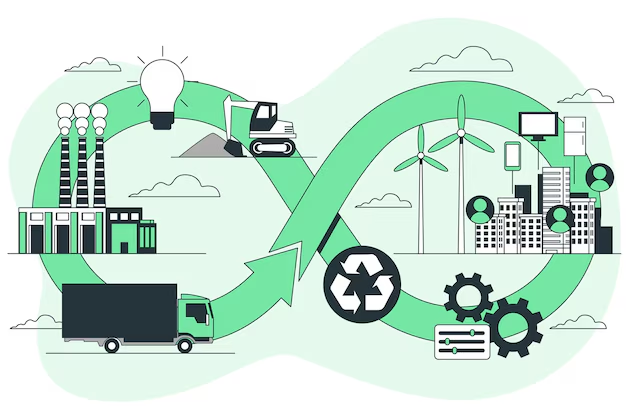As industries around the world face increasing pressure to adopt sustainable practices, the role of power management in manufacturing has never been more crucial. Sustainable manufacturing focuses on minimizing the environmental impact of production processes while maintaining high efficiency and profitability. At the heart of this transformation lies effective power management — the strategic use of energy to optimize productivity while reducing waste, emissions, and operational costs.
In a manufacturing setting, energy consumption can account for a significant portion of operational expenses and environmental footprint. By implementing efficient power management practices, manufacturers not only achieve cost savings but also contribute to broader environmental goals. In this context, power management is more than just a set of tools; it’s a key enabler of a greener, more efficient, and economically sustainable future for manufacturing industries.
This blog will explore how power management systems can help manufacturers streamline energy use, reduce their carbon footprint, and enhance their sustainability efforts. Through understanding the strategies and technologies available, manufacturers can take proactive steps toward achieving both their financial and environmental objectives.

Understanding Power Management in Manufacturing
Power management in manufacturing refers to the process of controlling and optimizing energy consumption throughout production operations. It encompasses a wide range of strategies, tools, and systems designed to ensure that power is used efficiently, reducing both operational costs and environmental impact.
In the manufacturing sector, power management typically involves monitoring, controlling, and analyzing energy usage across various stages of production. This includes everything from powering machinery and lighting systems to regulating temperature controls and other energy-consuming equipment. Effective power management requires a comprehensive approach, incorporating both hardware (such as energy-efficient machinery) and software (such as energy management systems) to optimize energy usage at every level of production.
Key elements of power management in manufacturing include:
- Energy Monitoring and Control: The ability to track energy consumption in real-time across various processes. This allows manufacturers to pinpoint inefficiencies and take immediate corrective actions.
- Automation and Optimization: Using intelligent systems like IoT devices and AI to automate energy management tasks, such as adjusting power use based on real-time demand and production schedules.
- Power Quality and Reliability: Ensuring that energy supply is stable and of high quality, preventing interruptions or fluctuations that can damage sensitive equipment and halt production.
- Energy Efficiency Technologies: Implementing solutions such as energy-efficient machinery, LED lighting, and variable speed drives to reduce energy consumption without sacrificing performance.
Incorporating these elements into manufacturing processes allows companies to reduce unnecessary energy usage, maintain smooth operations, and contribute to broader sustainability goals. A well-designed power management system not only enhances the efficiency of operations but also plays a crucial role in reducing waste and minimizing a factory’s environmental impact.

Key Challenges in Manufacturing Power Consumption
Despite the numerous benefits of power management, many manufacturers face significant challenges when it comes to managing energy consumption effectively. The complex nature of modern manufacturing processes, coupled with legacy systems and fluctuating energy demands, makes power management a difficult task. Below are some of the key challenges manufacturers encounter in managing power consumption:

1. High Energy Demand in Traditional Manufacturing Processes
Many manufacturing processes, especially in industries such as metalworking, automotive, and heavy machinery, are inherently energy-intensive. Traditional equipment often relies on outdated technology that is not optimized for energy efficiency, leading to excessive power consumption. These processes may consume large amounts of electricity for machinery operation, heating, and cooling, which increases energy costs and environmental impact.
2. Energy Inefficiencies in Machinery and Equipment
Older machinery and production equipment are often less efficient compared to modern alternatives. Worn-out machines or those not designed with energy efficiency in mind can result in higher operational costs. Additionally, many machines operate at full power even during periods of low demand or when idle, leading to unnecessary energy consumption.
3. Lack of Real-Time Energy Monitoring and Control
In many manufacturing facilities, there is insufficient monitoring of energy usage in real-time. Without accurate and timely data, it becomes difficult to identify inefficiencies or optimize energy consumption. This lack of visibility means that energy waste can go undetected, resulting in increased costs and missed opportunities for improvement.
4. Complex Production Scheduling and Variable Demand
Manufacturing environments often experience fluctuating energy demands due to shifts in production schedules, seasonal variations, or unexpected changes in order volumes. Power management systems need to be flexible enough to adjust energy consumption based on these varying needs. However, many manufacturers struggle to balance energy supply with production demand, leading to both overuse and underuse of energy resources at different times.
5. Integration of Renewable Energy Sources
As part of their sustainability goals, many manufacturers are moving toward integrating renewable energy sources like solar, wind, and biomass into their operations. However, the intermittent nature of renewable energy presents a challenge. The inability to store excess energy for later use or seamlessly integrate these energy sources with existing power systems can lead to inefficiencies and increased reliance on grid power during low production periods.
6. Power Loss and Inefficiencies in Distribution Networks
In some manufacturing facilities, the distribution of power within the plant is not optimized, leading to power loss during transmission. This inefficiency can occur due to outdated infrastructure, poor wiring, or mismanaged energy flows. Even small losses in power distribution can add up, increasing the overall energy demand and costs for the plant.
7. Regulatory Compliance and Environmental Standards
With increasing regulations surrounding energy consumption and carbon emissions, manufacturers face the challenge of staying compliant with environmental laws and standards. Failure to meet these regulations can lead to penalties, reputational damage, and additional costs. Manufacturers must constantly adapt their power management strategies to align with evolving regulatory requirements.
8. Resistance to Change and Initial Investment Costs
Transitioning to energy-efficient technologies and modern power management systems can involve significant upfront costs. This initial investment, combined with a resistance to change from employees or management accustomed to traditional systems, can create a barrier to the adoption of more sustainable power management practices.
Benefits of Effective Power Management in Manufacturing
Implementing effective power management strategies in manufacturing offers a range of significant benefits, both for the bottom line and the environment. By optimizing energy use, manufacturers can achieve not only cost savings but also contribute to sustainability goals and operational excellence. Here are the key benefits of effective power management in manufacturing:

1. Cost Savings
One of the most immediate and tangible benefits of effective power management is the reduction in energy costs. By monitoring and optimizing energy consumption, manufacturers can eliminate waste and ensure that energy is used efficiently across all processes. Technologies such as energy-efficient machinery, real-time monitoring, and automated energy controls help reduce unnecessary energy use, directly impacting the company’s bottom line.
- Reduced Utility Bills: Lower energy consumption leads to lower electricity bills, allowing manufacturers to reallocate resources to other critical areas of the business.
- Optimized Equipment Performance: Efficient power management extends the lifespan of equipment, reducing maintenance and replacement costs over time.
2. Reduced Environmental Impact
Power consumption in manufacturing is a major contributor to greenhouse gas emissions, and inefficient energy use can exacerbate the environmental footprint. By adopting sustainable power management practices, manufacturers can significantly reduce their energy waste, which in turn lowers carbon emissions and their overall environmental impact.
- Lower Carbon Footprint: Efficient energy use reduces emissions, helping companies meet sustainability goals and regulatory standards.
- Minimized Waste: Power management reduces energy waste and minimizes the use of non-renewable energy sources, contributing to a more sustainable future.
3. Regulatory Compliance
Governments around the world are introducing stricter energy consumption and environmental regulations, including mandatory reductions in carbon emissions and energy efficiency requirements. Effective power management helps manufacturers comply with these laws, avoiding potential fines or penalties for non-compliance.
- Staying Ahead of Regulations: Manufacturers who proactively adopt energy-efficient practices are better prepared for future regulatory changes.
- Sustainability Certifications: Meeting environmental standards and adopting green manufacturing practices can also improve a company’s reputation and lead to sustainability certifications, further enhancing market competitiveness.
4. Improved Operational Efficiency
Optimizing power usage often involves improving the overall efficiency of manufacturing processes. This can lead to smoother operations, reduced downtime, and enhanced productivity.
- Real-Time Data for Decision Making: With advanced power management systems, manufacturers can track energy usage in real-time, allowing them to make informed decisions about when and where to adjust energy use.
- Reduced Equipment Downtime: Energy-efficient machinery and systems require less maintenance and are less likely to experience unexpected failures, leading to higher uptime and more consistent production.
5. Enhanced Corporate Image
Companies that prioritize sustainability and energy efficiency are viewed more favorably by consumers, investors, and other stakeholders. Effective power management demonstrates a company’s commitment to reducing its environmental footprint and can help build brand loyalty.
- Positive Brand Perception: Adopting green energy practices can position a company as an environmentally responsible manufacturer, attracting eco-conscious customers and partners.
- Competitive Advantage: Companies that embrace sustainable manufacturing are often able to differentiate themselves from competitors in a crowded market.
6. Improved Energy Reliability and Stability
Power management systems ensure that energy supply is stable and reliable, which is crucial for maintaining continuous production in manufacturing environments. Voltage fluctuations or power outages can disrupt operations and damage sensitive equipment. With better power management practices, manufacturers can mitigate these risks.
- Consistent Power Supply: Automated systems can ensure that energy supply remains stable, even during periods of high demand or system outages.
- Reduced Equipment Damage: Power management protects machinery from voltage fluctuations, ensuring longevity and reliability.
7. Increased Employee Satisfaction
Energy-efficient practices not only benefit the organization but also improve the workplace environment. Efficient lighting, temperature control, and equipment performance create a more comfortable working environment, which can boost employee morale and productivity.
- Comfortable Workspaces: Reduced energy consumption in areas like lighting and HVAC systems enhances employee comfort, leading to improved focus and productivity.
- Employee Engagement: Workers who see their company taking steps toward sustainability may feel more engaged and motivated by the company’s environmental commitment.
8. Enhanced Innovation and Market Opportunities
Manufacturers who invest in power management systems and sustainable technologies often find themselves at the forefront of innovation. By exploring energy-efficient solutions, they may discover new opportunities to improve other aspects of their operations or even create new products or services that appeal to the growing market for sustainable goods.
- New Product Development: Sustainable practices can inspire new technologies, such as energy-efficient machinery or green product lines.
- Expanding into New Markets: As more consumers and businesses prioritize sustainability, manufacturers that adopt power management strategies may find new market opportunities both domestically and internationally.
Conclusion
In conclusion, effective power management in manufacturing is a pivotal factor in driving sustainability, operational efficiency, and long-term profitability. By optimizing energy consumption, manufacturers can not only reduce costs but also make significant strides toward meeting environmental goals, ensuring compliance with regulations, and enhancing their brand image. The integration of advanced power management technologies, such as real-time energy monitoring and AI-driven automation, provides manufacturers with the tools they need to streamline operations, reduce waste, and increase equipment lifespan. These efforts contribute to a more resilient, cost-effective, and eco-friendly manufacturing environment.
As the global push for sustainability continues to gain momentum, manufacturers who prioritize power management will be better positioned to succeed in an increasingly competitive and environmentally conscious marketplace. With the right strategies and systems in place, manufacturers can not only reduce their environmental impact but also unlock new growth opportunities, boost employee satisfaction, and improve overall productivity. Power management is no longer just a cost-saving initiative; it is a strategic approach that can transform the future of manufacturing and pave the way for a greener, more efficient industry.












